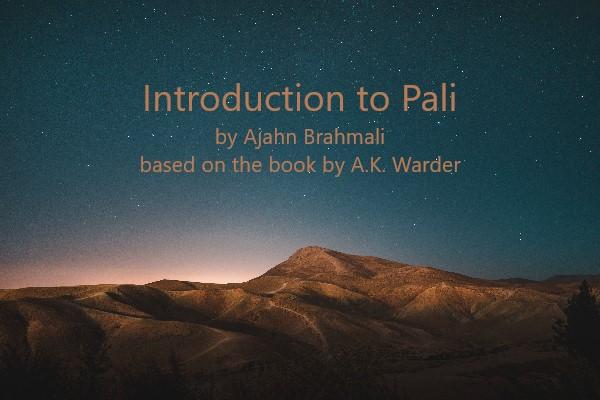
The Course
This course, Introduction to Pali by Ajahn Brahmali, is separated into 24 parts. There are approximately 20 hours of material, including lessons and exercises.
The course is intended for those who wish to read content from the Pali canon, rather than those who wish to read, write and construct terms in Pali.
The course uses Introduction to Pali by A. K. Warder as the core text, and covers the first 16 chapters.
Resources
The following resources are useful for the entire course:
PDF version of the course book: Introduction to Pali by A.K. Warder.
The text is available in print from the Pali Text Society in the UK.
PDF version of A Key to the Exercises in A.K. Warders Introduction to Pali.
Online version of the Pali Text Society's Pali-English Dictionary.
PDF version of the Pali Text Society's Pali-English Dictionary.
PDF version of the Pali Noun Declension Table.
PDF version of the Pali Verb Conjugation & Pronoun Declension Tables.
| Downloads | |
|---|---|
| Parts 1-5 Audio Files and Pali Phonetic Pronunciation [142 MB]: | download zip |
| Parts 6-10 Audio Files [130 MB]: | download zip |
| Parts 11-15 Audio Files [104 MB]: | download zip |
| Parts 16-20 Audio Files [122 MB]: | download zip |
| Parts 21-24 Audio Files [114 MB]: | download zip |
| All of the above PDF files [38.6 MB]: | download zip |
Offline Versions
We offer two versions of the course available for offline use: 'Resilient' and 'Website'.
Both the 'Resilient' and the 'Website' versions of the course are complete with all pdf's and audio required for the course. Once downloaded and installed on your device, neither version requires an internet connection to operate normally.
| Downloads | |
|---|---|
| Resilient Design [206 MB]: The 'Resilient' version offers:
| download zip |
| Website Design [657 MB]: The 'Website' version offers:
| download zip |
The Audio Player
Each part of this course has its own individual page.
Each of these pages has its recording of the class as given by Ajahn Brahmali.
The recordings are contained in the audio player for that page. The audio player looks like this:
The audio player is always available. Once you scroll past it, it should reappear in the top right hand corner.
The demonstration player on this page plays the short (4 minutes, 6 seconds) audio file: Pali Phonetic Pronunciation. This file relates to the Pali alphabet which is part of the first lesson, but is recreated below for reference.
On the player you will find a play button: ![]() When this button is pressed it will play the audio and the button will change to look like this:
When this button is pressed it will play the audio and the button will change to look like this: ![]() You can then press it again to pause the audio - Try it for yourself.
You can then press it again to pause the audio - Try it for yourself.
You can go back or forward 15 seconds in the recording by pressing either ![]() or
or ![]() .
.
The volume is controlled using this button: ![]() . Initially the volume button is set to maximum. When clicked for the first time it will be muted and shown as
. Initially the volume button is set to maximum. When clicked for the first time it will be muted and shown as ![]() . Subsequent clicks will turn up the volume in intervals of 25% and the button will change appearance accordingly:
. Subsequent clicks will turn up the volume in intervals of 25% and the button will change appearance accordingly: ![]()
![]()
![]() , until it comes back to full volume:
, until it comes back to full volume: ![]() . The volume control of the player is separate to the volume control of your computer, tablet, etc.. If you cannot hear the audio, then you may need to turn up the master volume control on your device. On iOS devices (iPad, iPhone, etc,.) the volume is always controlled by the device, in which case the Wisdom and Wonders logo will be shown instead of the volume control.
. The volume control of the player is separate to the volume control of your computer, tablet, etc.. If you cannot hear the audio, then you may need to turn up the master volume control on your device. On iOS devices (iPad, iPhone, etc,.) the volume is always controlled by the device, in which case the Wisdom and Wonders logo will be shown instead of the volume control.
The centre line e.g. 00:54 / 04:06, gives you the current time followed by the duration of the audio being played.
In addition, throughout the text on each page you will find "play time" buttons that look like this: . These button will play the audio from the time indicated.
Try pressing the buttons in the table below for yourself and notice how the current time changes in the audio player to reflect where you have jumped to.
Start here:
Alphabet |
|||||||||||
|---|---|---|---|---|---|---|---|---|---|---|---|
| place of articulation (ṭhāna) | manner of articulation (payatana) | ||||||||||
| consonants (vyañjana) | vowels (sara) | pure nasal (niggahīta) (nasal only. i.e. no release in the mouth, avivaṭena mukhena) |
|||||||||
| stops (phuṭṭha or vagga) | semi-vowel (īsaka phuṭṭha) (voiced) | sibilant (sakāra) (voice-less) | short (rassa) | long (dīgha) | com-pound (asa-māna) |
||||||
| voiceless (aghosa) non-aspirate (sithila) | voiceless aspirate (dhanita) | voiced (ghosa-vant) non-aspirate | voiced aspirate | voiced nasal (nāsika) |
|||||||
| gutturals (kaṇṭhaja) | k | kh | g | gh | ṅ | h | a | ā | e | ṃ | |
| palatals (tāluja) | c | ch | j | jh | ñ | y | i | ī | |||
| cerebrals (muddhaja) | ṭ | ṭh | ḍ | ḍh | ṇ | r, ḷ, ḷh | |||||
| dentals (dantaja) | t | th | d | dh | n | l | s | o | |||
| labials (oṭṭhaja) | p | ph | b | bh | m | v | u | ū | |||
Answers to Exercises
Each lesson has exercises at the end of it. At the start of the following lesson, Ajahn Brahmali takes the class through the exercises. The answers are revealed by clicking on the questions. Alternatively you can reveal the answers with the 'show all' and 'hide all' buttons. Try it for yourself:
That's it. Scroll down to the buttons underneath the lovely pictures of A.K. Warder and Ajahn Brahmali and click the button labelled '1' to go to the first lesson.

A. K. Warder

